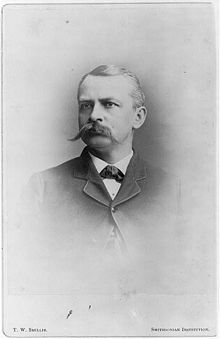Paul J. Pelz
| Paul J. Pelz | |
|---|---|
 |
|
| Born | 1841 Seitendorf, Silesia |
| Died | 1918 Washington DC |
| Occupation | Architect |
| Buildings | Library of Congress; Healy Hall, Georgetown University; Carnegie Library (now Hazlett Theater), Pittsburgh |
Paul Johannes Pelz (18 November 1841 – 30 March 1918) was a German-American architect, best known as the main architect of the Library of Congress in Washington DC.
Paul J. Pelz was born November 18, 1841 in Seitendorf (now Poniatów), Waldenburg, Silesia, now part of Poland. His father, Eduard Pelz, was elected as a representative of Silesia to the Frankfurt Parliament in 1848. Subsequent political repression led him to emigrate to the U.S. in 1851 while the rest of the family temporarily stayed in Breslau, where Paul studied at the colleges of St. Elizabeth and Holy Spirit. In 1858, Paul Pelz joined his father in New York City and served there as apprentice to architect Detlef Lienau. In 1864, he was employed as chief draftsman by Jewish architect Henry Fernbach, best known for his later design of New York's Central Synagogue. In 1866, Pelz became a member of the American Institute of Architects.
In 1867 he moved to Washington DC and was engaged as a civil engineer for the United States Lighthouse Board, where from 1872 to 1877 he served as chief draftsman. His work won a prize for the Lighthouse Board at the 1873 Universal Exhibition in Vienna.
In 1873, Pelz and John L. Smithmeyer, another Washington-based architect, together won the competition for the architectural plans for the Library of Congress. Their winning design proposal was partly based on notes Pelz had taken on prominent public libraries when he traveled to Europe to collect the prize in Vienna. In the ensuing years Pelz also partnered with Smithmeyer on other projects. However, the difficulties experienced on the Library of Congress project, with many delays from congressional dithering, eventually strained their collaboration. In 1888 Pelz became the lead architect for the Library of Congress as Smithmeyer was dismissed; Pelz in turn was dismissed in 1892 and succeeded by Edward Pearce Casey. Pelz had the main role in the design of the building and the execution of its exterior, while Smithmeyer was instrumental in securing the commission and Casey supervised most of the interior finishings.
...
Wikipedia
